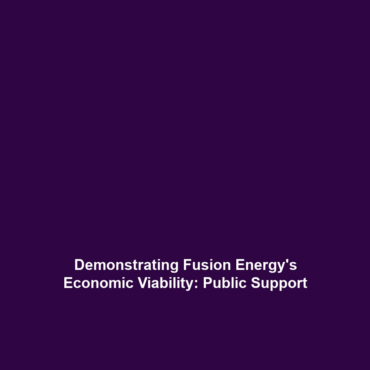Energy Potential of Fusion: Unlimited Clean Energy
Introduction
Fusion energy represents one of the most promising avenues for achieving a sustainable and virtually limitless source of clean energy. By fusing isotopes of hydrogen, particularly deuterium and tritium, into helium, fusion generates massive amounts of energy while producing minimal waste. In a world increasingly reliant on energy, understanding the energy potential of fusion is vital for addressing global energy demands and combatting climate change. As developments in fusion technology continue to advance, the implications for renewable energy paradigms are profound.
Key Concepts
Understanding Fusion Energy
Fusion is a nuclear reaction that occurs when two light atomic nuclei combine to form a heavier nucleus, releasing energy in the process. Key concepts include:
- Hydrogen Isotopes: The fusion process primarily involves deuterium (one proton, one neutron) and tritium (one proton, two neutrons), which are isotopes of hydrogen.
- Energy Release: When deuterium and tritium fuse, they produce helium and a neutron, releasing approximately 17.6 MeV of energy per reaction.
- Conditions for Fusion: Achieving fusion requires extremely high temperatures (millions of degrees) and pressure conditions to overcome the electrostatic repulsion between positively charged nuclei.
Fitting Fusion into the Energy Landscape
Fusion energy has the potential to complement existing renewable energy sources, providing a stable and consistent energy output. Unlike solar or wind energy, fusion does not rely on weather conditions and offers the possibility of baseload energy generation.
Applications and Real-World Uses
The applications of fusion energy are vast and could transform our approach to both energy production and consumption. Examples include:
- Electricity Generation: Once perfected, fusion reactors could supply cities with a nearly inexhaustible source of electricity, significantly reducing reliance on fossil fuels.
- Space Exploration: Fusion propulsion systems could enable deep space missions by providing a continuous thrust option with high efficiency.
- Industrial Processes: The heat generated from fusion could be harnessed for various industrial heating applications, promoting a more sustainable manufacturing sector.
Current Challenges
Despite the potential, several challenges hinder the research and development of fusion energy, including:
- Technical Challenges: Achieving the necessary conditions for sustained fusion reactions remains a significant scientific hurdle.
- Cost: The initial investment for fusion research and reactor construction is substantial, requiring ongoing funding and political support.
- Safety Concerns: Ensuring the safety and containment of fusion reactions to prevent any uncontrolled releases of energy is paramount.
Future Research and Innovations
Exciting innovations in fusion energy research are underway, promising advancements that could overcome existing challenges. Key areas of focus include:
- Tokamak Designs: Next-generation tokamaks, such as ITER, aim to demonstrate continuous fusion operations and improve energy output efficiency.
- Laser Fusion: Research into inertial confinement fusion uses powerful lasers to achieve fusion, with projects like the National Ignition Facility leading the way.
- Public-Private Partnerships: Collaborations between government agencies and private companies are fostering innovation and accelerating breakthroughs in fusion technology.
Conclusion
The energy potential of fusion, through the fusion of hydrogen isotopes like deuterium and tritium into helium, holds extraordinary promise for the future of clean, renewable energy. As researchers continue to tackle the scientific, technical, and financial barriers, the prospect of fusion energy becoming a cornerstone of global energy strategies becomes increasingly tangible. Keeping abreast of developments in fusion technology is critical. For those eager to learn more about this transformative energy source, check out our articles on Fusion Applications and Current Challenges in Fusion Energy.









